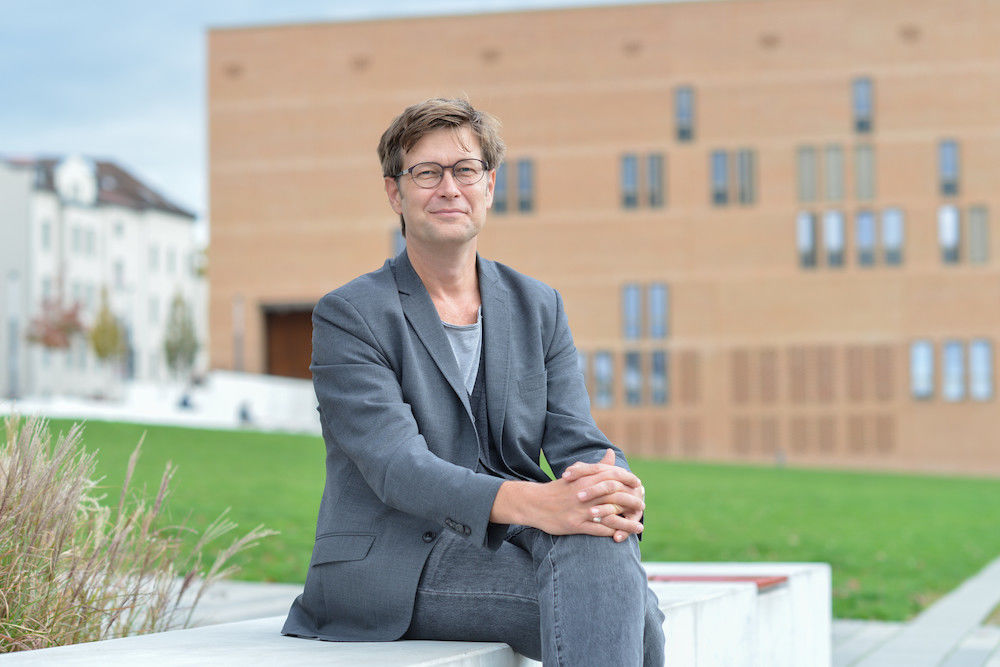Books from Buchenwald

The catalyst was a book by Jorge Semprún. The Spaniard emigrated to France at the age of 16, joined the Resistance there and was deported by the Nazis to Buchenwald concentration camp in 1944. In his novel “The Long Voyage”, he describes his five-day journey to Weimar. At the same time, he provides insights into life as a young resistance fighter, his experiences in the camp, and his political involvement in the supposedly peaceful world after the war. “I lay jet-lagged in a hotel in Boston reading Semprún. After that I couldn't sleep at all. That was the beginning of this project,” says Dr Stephan Pabst.
Pabst teaches and researches modern literature - since 2019 at the Institute of German Studies at MLU. Inspired by Semprún, he decided to intensify his research on Buchenwald and tap into the camp’s body of literature. Ettersberg Hill lies virtually at Stephan Pabst’s doorstep; he lives in Weimar, a place that could hardly be in starker contrast in terms of literary history. Here: the classicism of Wieland, Goethe, Herder and Schiller with its pursuit of harmony, humanity and tolerance. There: eight kilometres from the city centre, a camp in which over a quarter of a million people were imprisoned between 1937 and 1945 as a result of their ethnicity, faith, sexual orientation or political convictions. Around 56,000 of them died.
The term Holocaust too imprecise
Pabst’s project is ambitious as there has yet to be a comprehensive summary of the literature, neither for Buchenwald nor for any other concentration camp. Research is made more difficult not least by the fact that all literary works on this topic are generally considered to be part of Holocaust literature. “This indifference towards different groups of victims is certainly well-intentioned, but in the case of Buchenwald it only applies to a limited degree,” explains the researcher. Unlike Auschwitz, Treblinka or Sobibor, Buchenwald’s main purpose was not to exterminate Jews. The Jews were interred on Ettersberg Hill alongside communists, social democrats, Jehovah’s Witnesses, Sinti and Roma, homosexuals, criminals and so-called “anti-socials”. According to Pabst, “Buchenwald had an extremely heterogeneous national and social prisoner structure. Reducing this to the term Holocaust distorts its complexity. It obscures the political persuasions of the prisoners and the texts they later go on to write.”
In terms of literary history, the Buchenwald authors can be divided into two main groups: those who mainly report on their own experience, and those who claim to represent the entire camp. The totality perspective is found above all in the fictional, highly politicized literature of the 1950s - for example in “L’Arbre de Goethe” by Pierre Julitte or in Bruno Apitz’s “Naked among wolves”. Apitz certainly created the most famous work of Buchenwald literature. In the GDR, the novel became the hegemonic Buchenwald interpretation, the epitome of a camp narrative. “Literary research has studied Apitz intensively and after 1989 tried to ideologically and historically correct his perspective,” says Pabst. “However, this also led research to neglect other literature from Buchenwald.”
The literary works of the 1960s and 1970s moved away from the totalising literature of the immediate post-war period. Semprún, for example, largely wrote autobiographically, as did Fred Wander, a communist Jew, and the Hungarian writer Imre Kertész. According to Pabst: “The texts from this period are subjective and play down the political significance of the camp. But they are still political because they defend the ethics of freedom.”
Searching in language areas
Compared to other concentration camps, Buchenwald produced a large number of literary works. Some of them, such as Robert Antelmes’ “L'espece humaine” or Semprún’s novels, are a part of the established genre of camp literature, beyond the context of Buchenwald. Other texts are more on the fringes of historical literature, such as “The Seventh Well” by Fred Wanders or H. G. Adler’s “Panorama”. Much research has been conducted on the literature from the language area encompassing Western Europe - quite different to that from Eastern Europe. “The novel ‘A Cloud and Waltz’ by the Czech author Ferdinand Peroutka wasn’t translated until only recently,” explains Stephan Pabst. “Polish and Russian texts are almost unheard of, although Poles and Russians made up a large proportion of the prisoners.”
In order to find such texts, but also to discover unknown works by Western European authors, Pabst started the project “Buchenwald in Europe”. The project was launched last September at a four-day conference in Weimar, attended by researchers from Germany, France, Spain, Great Britain, Austria, the Netherlands, Luxembourg, Hungary, Poland and Serbia. “Our aim is to bring experts on board from as many language areas as possible, because otherwise researching and classifying this special type of literature is nearly impossible,” explains Pabst. The event highlighted not only unknown texts, but also new findings on the dissemination of prisoner groups throughout the respective countries. But it has also revealed gaps that still need to be filled: “In the coming months, we hope to expand our network and establish contacts, for example in Belgium or Scandinavia. This should enable the white areas to gradually disappear from the map of Buchenwald literature.”
Dr Stephan Pabst
Institute of German Studies
Telephone: +49 345 55-23665
Mail: stephan.pabst@germanistik.uni-halle.de
